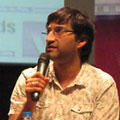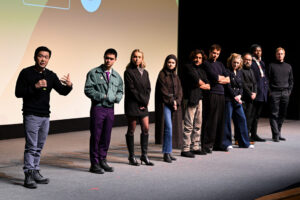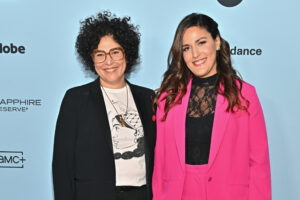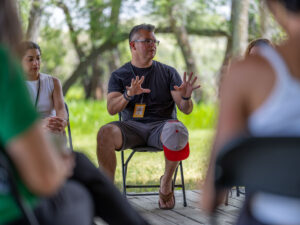Asif Kapdaia leads a Q&A at the Kunzum Travel Cafe in New Delhi, India.
Asif Kapadia, director, Senna
FILM FORWARD was a chance for me to continue the cultural dialogue I have been having with India through cinema all of my life.
My parents were from Gujarat, they emigrated to the UK in 1966, and I was born and bought up in London. My family never returned to India while I was growing up. As a result, I never had the chance to meet my grandparents, I didn’t really understand where my parents had come from, and I had very little knowledge of my Indian heritage. So there was always a question in the back of my mind while growing up: Was I English? British? Was I an Indian?
I first visited India with my mother when I was 21. Walking down a crowded street in her native town of Navsari, I realized that for the very first time in my life I looked the same as everyone around me. Even still, I knew I didn’t walk right, talk right–I couldn’t even sit down without giving away the fact that I was not from there. On returning home it became clear: I was first and foremost a Londoner.
My way to learn about India and to experience its culture was through cinema. When I was young it was the songs by Lata Mangeshkar that my mother used to listen to and sing along with while using her sewing machine, then it was the films of Amitabh Bachchan and Raj Kapoor my family watched on a rented VHS machine.
Once I became a filmmaker, I went to India to shoot my graduate short, The Sheep Thief, from the Royal College of Art in rural Gujarat and Rajasthan. A few years later I returned to shoot my debut feature The Warrior in Rajasthan and the epic Himalaya.
Although I live in London, I have not shot many films here. I like going away to places, being an outsider, seeing the world and the people with fresh eyes.
Looking back now, I find that most of the films I have made are about ‘outsiders’ in one way or another. It is a theme I have returned to time and time again.
SENNA is my first feature documentary, and I’ll be eternally grateful to the Sundance Film Festival as it helped to put our film on the international map.
So I feel like I owe Sundance Institute a lot. and when Alesia Weston asked me to be a part of the Mumbai Mantra Screenwriters Lab in India March 2011, I immediately agreed to take part. No matter what I might be doing, I would be there.
August 2011
A few months later I received an email asking me to return to Park City, as SENNA was one of the ten films selected for FILM FORWARD: Advancing Cultural Dialogue. The films would be shown around the world, and I was being asked to go India to screen SENNA. I couldn’t wait.
March 2012
I flew to India for two weeks. For the first week I was an Advisor on the inaugural Mumbai Mantra | Sundance Institute Screenwriters Lab. It was an amazing, intense, and emotional week up at Lake Pavna with my fellow Advisors, many of them inspirational screenwriting heroes of mine and supremely talented Indian screenwriters.
Mumbai March 16
I set off from Lake Pavna at 6.30 a.m. for the three hour drive back to Mumbai to join the FILM FORWARD team, and I was thrown in at the deep end with my first screening & Q&A.
1:30pm: SENNA and Q&A with filmmaker Asif Kapadia
FICCI Frames at Renaissance Mumbai Convention Centre Hotel
I was not ready for the experience of the screening of SENNA at FICCI frames. It’s a business/trade show with, and my first impression was that this was not the best place to show films in the middle of the day, particularly documentaries. It was not a place for filmmakers, and my friends in Mumbai had already warned me that the passes for FICCI frames were too expensive for them to ever attend.
The next surprise was the screening room itself, which had two small screens side by side–luckily both were showing SENNA at the same time.
I asked the projectionist why we needed two screens when pretty much every other cinema in the world felt that one screen was enough. I was told, “The people on this side can look at this screen, people on that side can look at that screen.” It was an interesting argument. There was little I could do, as our film was due to begin, so I gave him my best Indian shake of my head and turned away. Only then did it hit me, the room was empty. All of the FICCI delegates were busy getting their lunch. Also, there were so many other events taking place in the trade show that no one wanted to watch our film–that’s if they knew it was on. The screening began with less than 10 people in the room, (half of the audience were members of the FF team). I honestly couldn’t think of a less well attended screening of SENNA, anywhere in the world… ever! This is in a country with a population of 1.2 billion.
I left the screening after 10 minutes feeling pretty dejected and exhausted as I’d been up since 5.30 a.m. to take a 3 hour drive in order to be at FICCI frames in time to introduce the film.
Now this is where I should explain the SENNA effect. We’ve always been very lucky with our film, something magical happens when we screen the movie, no matter how large the audience at the start of a screening, there will always be more in the room at the end, without fail. Ayrton’s passion and charisma draws people into the dark room, and even if people have seen the film before, they sit down or stand in the aisle to watch it again and again.
I returned for the last 20 minutes to find the room nearly full. People were standing at the back and on the side. Delegates were still walking in and out continuously (maybe FICCI should put revolving doors in ahead of next year?) but at least more stayed than left.
The Q&A seemed to go well. There was a mixture of industry delegates and documentary and fiction filmmakers., No matter where we are there is always a F1/Senna fan or two in the screening, proudly wearing their Nacional cap or Senna t-shirt, always there for us, supporting the film. There were many questions asking how the film was put together, where the footage came from, and the time and cost of making the documentary. There was also a question about the score by the fantastic Antonio Pinto, whose music provides the Brazilian soul for the film. The Q&A went on for some time and was very enjoyable. It was a nice end to the screening.
March 17th, 4:00 p.m. – 6:00 p.m.: SENNA with Q&A
6:00 p.m. – 7:00 p.m.: Documentary workshop with Asif Kapadia
Pelicula Auditorium, Whistling Woods International
This was my first experience at Whistling Woods International, an amazing campus and building with very impressive facilities. I arrived to hear the great news that the SENNA screening had been so popular that it had moved from a small room to their main lecture theatre. I crept into the back and saw that the room was almost full. We had a very enjoyable Q&A moderated by the screenwriting tutor (and screenwriter) Anjum Rajabali. I was really impressed by the students, they had studied the film, they took note of the smallest details, they asked how the film was put together. In general, they asked some very searching and original questions, not letting me get away with dodging their questions. They had been given a hint by Anjum that there was possibly one shot in the film which was not an archive shot, and quite a few of them became interested in trying to spot the shot. It was great fun, I hope I can return to the school in the future.
There have been many SENNA screenings and Q&As over the last few years, so it’s pretty hard to find an original question, something that no one has ever asked before. But one of the students did mention a similarity he saw in SENNA to Martin Scorsese’s Raging Bull. No one has ever bought that film up in a Q&A before, people generally ask about other docs. But as I come from a drama background, most of my references are actually fiction films. Raging Bull is one of my favorite films of all time, Scorsese is a hero, (the title sequence of my first The Warrior is secretly inspired by the opening titles of Raging Bull).
From the very earliest conversations during the development of SENNA, the writer Manish Pandey and I discussed Raging Bull as I felt there are only a certain number of fights you can show in a film about the career of a boxer. In the same way there are only a certain number of races you can show in a movie about the amazing career of a Formula One driver. Each race has to move the story forward by revealing something new about the central character, and each race should have a different visual style.
Boxing, like F1, is a sport where the athlete is potentially risking their life each time they do the thing they love. Boxing and F1 are famous for the politics going on behind the scenes, and some might say the corruption which has affected the outcome at key points in history. So a special mention to the young man who spotted the link!
March 18th
Team FILM FORWARD flew to Delhi. Nothing at all went wrong on the short journey from the hotel to the airport, no one forgot their passport in the safe in their room, no one was accidentally taken to the international airport rather than the domestic one, no one was thrown out of a rickshaw with their luggage on a dusty road. It all went very smoothly…
March 19th
10:00 a.m.: SENNA WITH Q&A
AMITY UNIVERSITY
We drove south east out of Delhi to Noida, close to where the new Indian Formula One track has been built. We arrived at the University and I was introduced to the Asst. Professor at Amity School of Communication. She asked with a smile me if I could remember her–I wasn’t sure where we had met but she did look familiar.
She introduced herself as Gauri Chakraborty. I couldn’t believe it, Gauri was many years ago a student from the Pune Film Institute, and she worked as production manager on my graduate student short The Sheep Thief, my first film in India. It was a very tough film to make, we were all so young and so out of our depth. It was a nightmare of a shoot, all of the crew went a little crazy making the film. Some people have never quite been the same since… Gauri and I had not seen one another since I returned to London to edit the film in the spring of 1997. It was lovely to see her again, and the SENNA screening was for us a continuation of a cultural dialogue that began 15 years ago.
We entered the lecture theatre together and I was surprised to find a huge auditorium, full with eager students. The screening was excellent, the students were fantastic, very enthusiastic, and we had a great conversation about how the film was constructed. It was so enjoyable that when I returned to base I mentioned to Linda Knowlton that she should try to screen her brilliant documentary Somewhere Between at Amity, which she did a few days later.
6:00 p.m.: SENNA WITH DOCUMENTARY WORKSHOP
THE AMERICAN CENTER
This was the only workshop where I had the chance to show some of my fiction work. I had a workshop planned but in the end, due to problems with the projector, I only played a single clip from my debut feature The Warrior, specifically a key scene where a young boy is shown a severed head and asked; “Is this your father?” This scene came from a footnote in a book of Japanese stories. It’s a very dark, powerful scene posing many questions. The entire screenplay was developed from those four lines and into the movie we eventually shot in Rajasthan with the brilliant actor Irrfan playing the lead.
I also spoke about learning to trust your instincts as a filmmaker. With SENNA, the unique selling point is the fact that we do not have any on-screen contemporary talking heads, as we chose to only use archive footage, and we let Ayrton Senna tell his own story. There is no voice over, or narrator. The idea works, and so it now seems like an obvious way to make the film, but during the early stages of editing, it was very different. There were many difficulties in getting people to believe in the concept, as it’s not the way most documentaries are made. But the aim should always be to trust your instinct to find the best way to tell each particular story.
http://span.state.gov/mar-apr2012/eng/film-workshop.html
MARCH 20th
SENNA WITH Q&A
THE AMERICAN CENTER
A special screening for a younger audience. It was great to see so many teenagers arriving for the screening, though it was probably a bit too challenging for the those in their lower teens as there are a lot of English subtitles to read in SENNA. The older members of the audience were thrilled by the film and had a lot to say about it. I guess this was Film Forward at its best. This was a totally new audience viewing SENNA, and there is no way we would have been able to do this particularly screening in any other way.
7:00 p.m.: SENNA WITH Q&A
KUNZUM TRAVEL CAFÉ
I’d have to say one of my favorite screenings was the final one at the Kunzum Café, which was a small travel café. We arrived to find people sat on stools, cushions, and cross legged on the floor, the projector on a small table, the air con rumbling away by the door. Quickly the room filled up so much that people had trouble squeezing in through the door.
The screening and Q&A that followed was fantastic. It was intimate and it genuinely felt like a conversation with friends. There was no microphone, no stage, just a few cinephiles, F1 fans, and artists in a cafe taking about movies. This was what I had hoped we would find with FILM FORWARD, so the final screening was a perfect way to end the trip.
http://www.sundance.org/video/after-hours-in-delhi-with-senna-director-asif-kapadia/
http://f1podcast.co.uk/2012/03/21/in-reel-time-senna/
FILM FORWARD in India was a wonderful experience. In general, the questions were pretty similar to what I’ve been asked around the world, but I guess as the film has been put together in a particular way, those questions will always come up. I really enjoyed traveling with Linda Goldstein Knowlton, and it was so moving to see her film Somewhere Between with an audience in India.
Finally, I thought it was apt that while traveling around India with SENNA Sachin Tendulka, Indian’s great sporting hero finally hit his 100th first class century. That evening in the hotel bar I mentioned his achievement to some of the Lab Advisors from the US. I tried to explain how hard it is to score a century in cricket, and I tried to explain the rules of cricket to them. I tried and failed to find ways of comparing hitting a century in cricket to something similar in baseball, basketball, or American football. I wanted them to understand what Sachin means to Indians, both cricket fans and not… the truth is that none of them had ever heard of him, they didn’t know a thing about cricket, they didn’t really care about his achievement or why he means so much to Indians–so I gave up. It reminded me of the many conversations I have had over the last five years while making SENNA. It was impossible to explain to people, close friends why I wanted to direct a feature documentary about a motor racing driver, particularly to people who had no interest in the sport. In the end, the only answer was to make the film and to show them. What has been interesting with SENNA is that the less people know about the film the greater the emotional journey for the audience, and this has been the same for audiences in the U.S. as for audiences in India.







